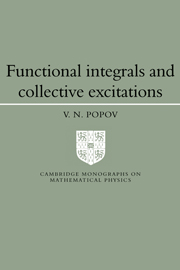Book contents
- Frontmatter
- Contents
- Preface
- Part I Functional integrals and diagram techniques in statistical physics
- Part II Superfluid Bose systems
- Part III Plasma and superfluid Fermi systems
- 9 Plasma theory
- 10 Perturbation theory for superconducting Fermi systems
- 11 Superconductivity of the second kind
- 12 Collective excitations in superfluid Fermi systems
- 13 Bose spectrum of superfluid Fermi gas
- 14 Superfluid phases in 3He
- 15 Collective excitations in the B-phase of 3He
- 16 Collective excitations in the A-phase of 3He
- 17 Superfluidity and Bose excitations in 3He films
- Part IV Crystals, heavy atoms, model Hamiltonians
- References
- Suggested further reading
- Index
11 - Superconductivity of the second kind
Published online by Cambridge University Press: 01 June 2011
- Frontmatter
- Contents
- Preface
- Part I Functional integrals and diagram techniques in statistical physics
- Part II Superfluid Bose systems
- Part III Plasma and superfluid Fermi systems
- 9 Plasma theory
- 10 Perturbation theory for superconducting Fermi systems
- 11 Superconductivity of the second kind
- 12 Collective excitations in superfluid Fermi systems
- 13 Bose spectrum of superfluid Fermi gas
- 14 Superfluid phases in 3He
- 15 Collective excitations in the B-phase of 3He
- 16 Collective excitations in the A-phase of 3He
- 17 Superfluidity and Bose excitations in 3He films
- Part IV Crystals, heavy atoms, model Hamiltonians
- References
- Suggested further reading
- Index
Summary
The interaction of a superconductive system with electromagnetic field results in some interesting effects. One of the most remarkable is the Meissner effect, the consequence of which is that a sufficiently weak magnetic field is pushed out of the superconductor. There are two possible scenarios when the magnetic field is increased:
(1) The field penetrates the superconductor, changing it into the ordinary state. Such superconductors are called ‘superconductors of the first kind’.
(2) What emerges in the system is the so-called ‘mixed state’. During this process the field partially penetrates the superconductor in which a periodic lattice of quantum vortices is formed. This effect is called ‘superconductivity of the second kind’, and the superconductors exhibiting this type of superconductivity are called the second kind superconductors.
The creation of the quantum vortex lattice was predicted by Abrikosov (1952) in the framework of the phenomenological superconductivity theory of Ginsburg & Landau (1950). Formulation of the microscopic superconductivity theory allowed the derivation of the Ginsburg–Landau equations microscopically and the understanding of the meaning of the parameters appearing in the equations. In particular, it turned out that the effective charge of the phenomenological theory is equal to twice the electron charge, i.e. that it corresponds to the charge of a Cooper pair.
In this section we shall apply the functional integration method to some of the problems of superconductivity of the second kind. First, we shall show that the homogeneous superconducting state cannot exist in a constant homogeneous magnetic field.
- Type
- Chapter
- Information
- Functional Integrals and Collective Excitations , pp. 76 - 89Publisher: Cambridge University PressPrint publication year: 1988



